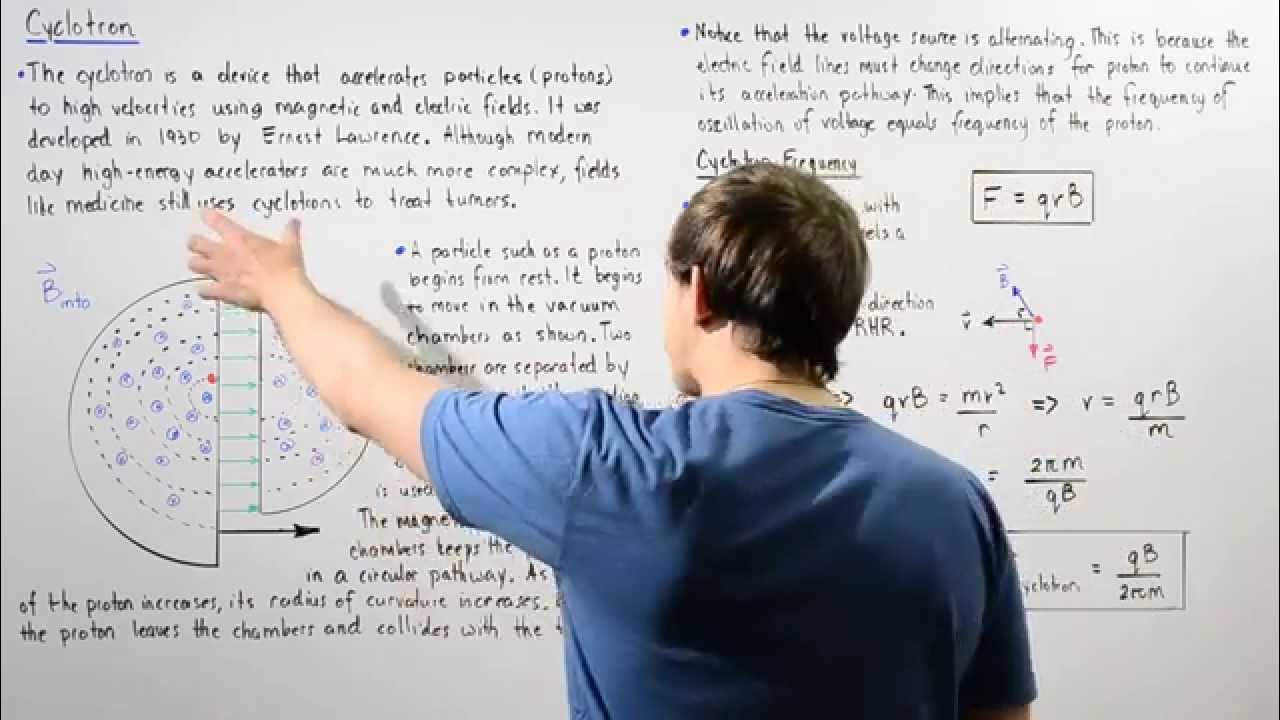Principle and Working of Cyclotron
Summary
TLDRThe Cyclotron, invented by E.O. Lawrence and M.S. Livingstone in 1934, is a device that accelerates charged particles using an oscillating electric field within a magnetic field. This technology enables the production of high-energy particles for nuclear reactions. The device consists of two half-cylinder 'dees' connected to an alternating voltage source, creating an electric field that propels particles in a circular path, increasing their velocity with each orbit. As the particles gain energy, their radius expands until they are ejected through a window, ready for high-energy collisions with a target.
Takeaways
- ⚛️ Cyclotron is a device developed by E.O. Lawrence and M.S. Livingstone in 1934 to accelerate charged particles like protons and deuterons.
- 🔋 The device accelerates particles using an oscillating electric field, allowing them to cross the same field repeatedly with the aid of a strong magnetic field.
- 🌀 Two hollow half cylinders called dees, made of high conductive metals, are placed face-to-face with a small gap and connected to an alternating voltage source.
- ⚡ An electric field is created between the dees by oscillating polarity, with D1 being positive when D2 is negative, and vice versa.
- 🧲 Electromagnets are placed above and below the dees to create a perpendicular magnetic field to the direction of the electric field.
- 🚀 A positively charged particle is accelerated by the electric field, gaining speed until it enters a dee where the electric field is zero but the magnetic field guides it in a circular path.
- 🔄 The particle moves in a circular path with a radius determined by r=mv/qB, making semi-circles and being accelerated each time it exits a dee and encounters the electric field again.
- 📈 With each oscillation and acceleration, the velocity of the charged particle increases, causing it to move in larger circular paths within the dees.
- 🌌 The process continues until the particle reaches a high enough velocity and energy, at which point it is ejected through a window to hit a target.
- 🎯 The cyclotron is used in nuclear physics for bombarding nuclei with high-energy particles, resulting in nuclear reactions.
Q & A
What is a cyclotron?
-A cyclotron is a device used to accelerate charged particles, such as protons and deuterons, to high energies using an oscillating electric field and a strong magnetic field.
Who developed the cyclotron and when?
-The cyclotron was developed by E.O. Lawrence and M.S. Livingstone in 1934.
What are the primary components of a cyclotron?
-The primary components of a cyclotron include two hollow half cylinders called dees, an alternating voltage source (oscillator), and electromagnets placed above and below the dees.
How do the dees in a cyclotron function?
-The dees create an oscillating electric field between them by connecting to an alternating voltage source. One dee becomes positively charged while the other becomes negatively charged, and this polarity alternates, creating an electric field that accelerates charged particles.
What role do the electromagnets play in a cyclotron?
-The electromagnets create a magnetic field perpendicular to the electric field generated by the dees. This magnetic field forces the charged particles to move in a circular path within the dees.
Why is the entire arrangement of the cyclotron sealed in a vacuum box?
-The arrangement is sealed in a vacuum box to eliminate air resistance and other particles that could interfere with the acceleration and path of the charged particles.
What happens to a charged particle when it first enters the cyclotron?
-When a positively charged particle enters the cyclotron, it is accelerated by the electric field between the dees. Once inside a dee, the electric field is zero, but the magnetic field causes the particle to move in a circular path.
How does the charged particle gain speed in a cyclotron?
-The charged particle gains speed each time it crosses the gap between the dees. The electric field in the gap accelerates the particle, increasing its velocity each time it exits and re-enters the dees.
What determines the radius of the particle's circular path in a cyclotron?
-The radius of the particle's circular path is determined by the particle's velocity and the strength of the magnetic field, according to the formula r = mv/qB.
What happens when the particle reaches the edge of the cyclotron?
-When the particle reaches the edge of the cyclotron and can no longer increase its radius, it is ejected through an exit window. At this point, the particle has gained high energy and can be directed at a target for experiments or practical applications.
Outlines

This section is available to paid users only. Please upgrade to access this part.
Upgrade NowMindmap

This section is available to paid users only. Please upgrade to access this part.
Upgrade NowKeywords

This section is available to paid users only. Please upgrade to access this part.
Upgrade NowHighlights

This section is available to paid users only. Please upgrade to access this part.
Upgrade NowTranscripts

This section is available to paid users only. Please upgrade to access this part.
Upgrade NowBrowse More Related Video

Cyclotron and Cyclotron Frequency

Top 10 Cool Inventions by Women That Changed the World

ORIGENS DA BÍBLIA: Descubra quem inventou os livros bíblicos.

Is Mathematics Discovered or Invented? (PETA 1 - MMW) ☁️

पंखे का आविष्कार किसने किया । Fan ka avishkar kisne kiya l A1 history

L-01 || Unit-03 || Cyclotron (Part-1) ||
5.0 / 5 (0 votes)